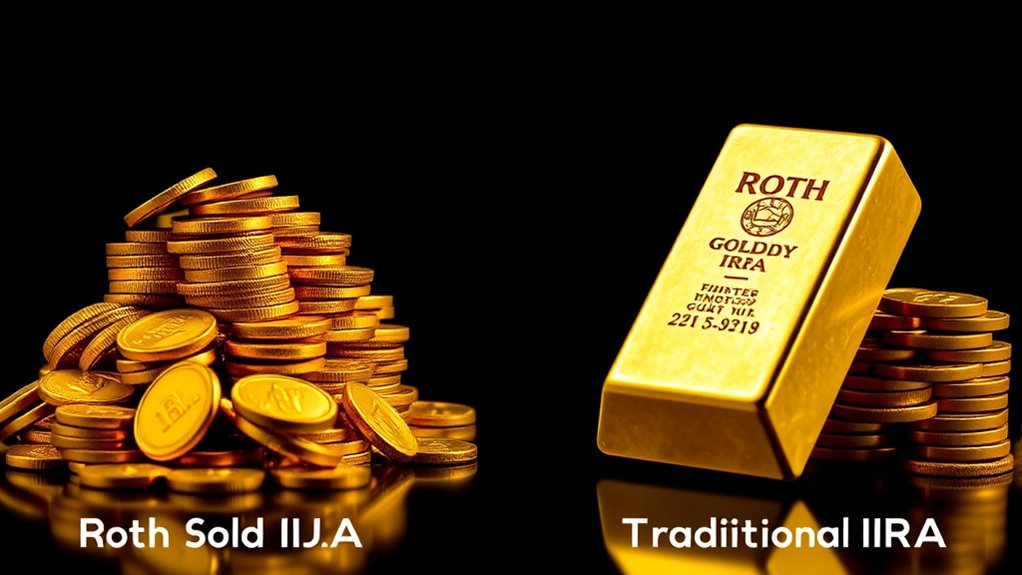Choosing between a Roth and Traditional Gold IRA depends on your current tax situation and future plans. If you expect higher taxes later, a Roth provides tax-free growth and withdrawals, making it attractive. But if your current taxes are higher, a Traditional IRA might save you more now with tax-deferred growth. Both have pros and cons, so understanding how they fit your goals can help you make the best move. Keep exploring to see which option suits you best.
Key Takeaways
- Roth IRAs offer tax-free growth and withdrawals, ideal if you expect higher future tax rates; traditional IRAs provide immediate tax deductions.
- Traditional IRAs are better for current high earners seeking immediate tax benefits, while Roths suit those anticipating higher future taxes.
- Roth contributions are limited by income, but qualified withdrawals are tax-free; traditional IRAs have no income limits but taxed upon withdrawal.
- Roth IRAs have no RMDs, providing more flexibility, whereas traditional IRAs require minimum distributions starting at age 72.
- Consider storage costs, liquidity, and long-term goals, as physical gold in IRAs involves additional complexities regardless of the account type.

Are you trying to decide between a Roth and a Traditional Gold IRA for your retirement savings? Understanding how each account is taxed can make a big difference in your long-term wealth. With a Traditional Gold IRA, you contribute pre-tax dollars, which means you get an immediate tax deduction, lowering your taxable income today. However, when you start withdrawing funds in retirement, those distributions are taxed as ordinary income. This setup works best if you expect to be in a lower tax bracket after you retire, because you’ll pay less in taxes on your withdrawals than you saved upfront. On the other hand, Roth Gold IRAs are funded with after-tax dollars. You don’t get an immediate deduction, but your investments grow tax-free, and qualified withdrawals in retirement are completely tax-free. If you believe your tax rate will be higher in the future, a Roth offers significant advantages, as you won’t owe taxes on your gold’s growth or your distributions.
Both types of IRAs benefit from tax-deferred growth on your gold investments, meaning your assets can compound over time without annual taxes eating into your gains. But your decision hinges on your current vs. future tax situation. If you’re in a high tax bracket now and expect lower rates later, a Traditional IRA might be more appealing. Conversely, if you’re currently in a lower tax bracket but anticipate higher taxes down the line, the Roth could save you money in the long run. Remember, Roth IRAs have income limits that restrict high earners from making direct contributions, while Traditional IRAs do not. This means if you earn above certain thresholds, you might need to explore other options like a SEP Gold IRA, which allows higher contributions for self-employed individuals.
When it comes to access, Roth IRAs provide more flexibility. Contributions can be withdrawn anytime without taxes or penalties, and there are no required minimum distributions (RMDs) during your lifetime. Traditional IRAs, however, require RMDs starting at age 72, forcing you to start taking withdrawals whether you need the funds or not, which could lead to higher taxes. With gold holdings, liquidity is also a factor—physical gold isn’t as easily accessible as stocks or bonds, and you won’t earn dividends or interest, unlike traditional investments within IRAs. So, if liquidity and income generation are priorities, a Roth IRA’s investment options might suit you better. Additionally, physical gold must be stored securely, which can add to the complexity and costs of a Gold IRA. Proper tax planning can help optimize your retirement strategy and minimize surprises at withdrawal. Being aware of regulatory considerations related to gold IRAs can ensure compliance and protect your investments. Considering the long-term growth potential of your investments can also influence your choice, especially when planning for large future expenses or legacy goals. Understanding the tax implications of each option can help you plan more effectively for your retirement goals.
Frequently Asked Questions
Can I Convert a Traditional Gold IRA to a Roth Gold IRA Later?
Yes, you can convert a traditional gold IRA to a Roth gold IRA later. The IRS permits this, but you’ll need to complete the proper paperwork, like IRS Form 8606, and pay taxes on the converted amount since it’s treated as taxable income. Make sure your traditional IRA has sufficient funds, and consider timing the conversion during a market dip to minimize taxes. No income limits restrict this conversion.
How Do Early Withdrawal Penalties Differ Between Roth and Traditional Gold IRAS?
Think of early withdrawal penalties like a security guard blocking your exit—differently for Roth and traditional IRAs. With a Roth, you can freely withdraw contributions anytime without penalty, like a pass for friends. But earnings face a 10% penalty and taxes if taken early. Traditional IRAs penalize both contributions and earnings equally, like a strict gatekeeper. So, Roths offer more flexibility on your initial contributions, but earnings are more protected in the long run.
Are There Specific Gold Requirements for Roth Versus Traditional IRAS?
You should know that both Roth and traditional IRAs have the same gold requirements. The gold must meet IRS standards — 24-karat pure gold with at least 99.5% fineness, in approved coins or bars. Both types require the gold to be stored by a qualified custodian in an IRS-approved depository. So, your gold investments need to comply with these strict purity and storage rules regardless of the IRA type.
What Are the Impact of Inflation on Roth and Traditional Gold IRAS?
When it comes to inflation’s impact on Roth and traditional gold IRAs, you’re caught in a tight spot. Inflation erodes the real value of your savings, but gold’s role as an inflation hedge shines through. With a Roth IRA, your withdrawals are tax-free, helping you keep pace with rising prices. Traditional IRAs grow tax-deferred, but inflation can diminish your future purchasing power when you withdraw. Both strategies need careful balancing to stand the test of time.
Which IRA Type Offers Better Estate Planning Benefits?
You’re asking which IRA type offers better estate planning benefits. Roth IRAs typically provide advantages like tax-free inheritance, no RMDs, and flexible beneficiary options, making them ideal for multi-generational wealth transfer. Traditional IRAs may limit estate planning due to RMDs and taxable distributions. If you want to maximize legacy potential and minimize taxes for heirs, a Roth Gold IRA generally offers stronger estate planning benefits.
Conclusion
Think of your retirement savings as a mighty river. With a Roth Gold IRA, you’re planting seeds now to enjoy a lush, tax-free oasis later. A Traditional Gold IRA is like saving water for a drought—paying taxes upfront means fewer surprises down the line. Ultimately, the choice depends on your journey’s destination. Decide which path feels right for you, and watch your financial river flow smoothly toward a secure, golden future.









